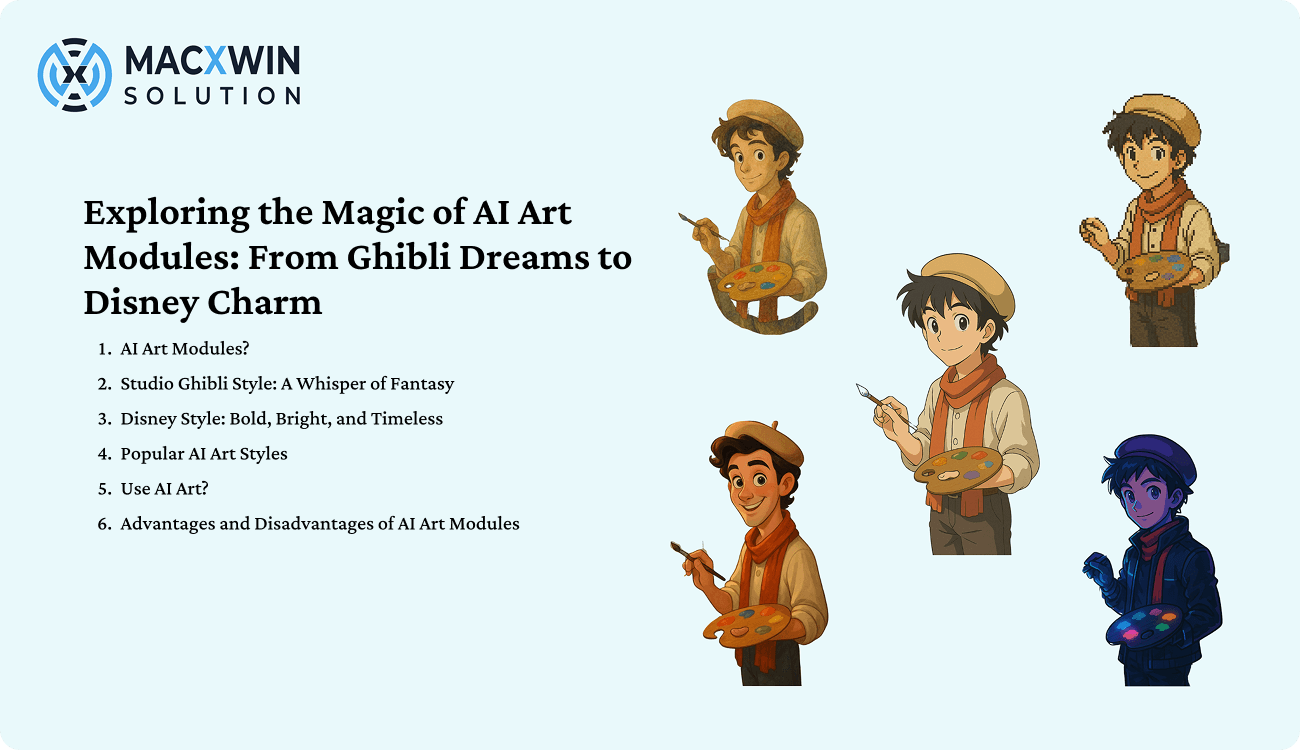Artificial intelligence has quickly developed into a potent weapon in the creative industries in recent years, and nowhere is this more exquisitely demonstrated than in the field of AI-generated art. AI art modules are making it simpler than ever to emulate the aesthetics of renowned animation studios like Studio Ghibli, Disney, and others, whether they be bold digital fantasy or whimsical, hand-drawn aesthetics.
What Are AI Art Modules?
AI art modules are specialized models trained on large datasets of visual styles. These models create or alter images according to particular creative styles using machine learning, especially deep learning and diffusion approaches. With just a few clicks or instructions, these tools enable you to produce captivating pictures, regardless of your background as a digital artist, content provider, or simply an inquisitive adventurer.
AI learns the subtleties that characterise different art genres by examining thousands of pictures, paintings, and frames. The outcome? A computer artist capable of emulating the sharp, expressive features of a Disney character or the gentle watercolour tones of a Studio Ghibli scene.
Studio Ghibli Style: A Whisper of Fantasy
Studio Ghibli is renowned for its dreamy vistas, delicate textures, and childish sense of wonder. Some of its best-known works include Spirited Away and My Neighbour Totoro. Artificial intelligence modules that have been trained on Ghibli-style visuals emphasise delicate lighting, natural colour schemes, and minute environmental elements.
Storytellers and fans of fantasy appreciate these Ghibli-inspired sculptures. Imagine supplying an AI model with a text query such as “a girl riding a dragon above a valley at sunset” and getting a stunning visual that appears to be from a Hayao Miyazaki movie. AI illustrations in the Ghibli style can provide a magical touch to your work, whether you’re creating a world or illustrating a children’s book.
Disney Style: Bold, Bright, and Timeless
Clean lines, exaggerated facial expressions, large eyes, and vibrant colours are characteristics of the Disney art style. From timeless figures like Mickey Mouse to contemporary blockbusters like Frozen and Encanto, the Disney formula never fails to captivate audiences of all ages.
Character design and emotion are the main emphasis of AI modules that mimic Disney aesthetics. You may create whole cast graphics that resemble Disney films, replete with endearing grins, dramatic gestures, and a sense of fantasy. These models are frequently used by artists to create realistic depictions of real people, animals, or fictional characters that seem to have been lifted from a Disney movie.
“Disney-fying” oneself is a popular social media trend where individuals post selfies to explore how they may appear as a Disney prince or princess. This tendency is becoming more accurate and accessible than ever thanks to AI.
Popular AI Art Styles
AI art modules come in a variety of styles to suit almost any creative concept, not only Ghibli and Disney
𝗔𝗻𝗶𝗺𝗲 𝗦𝘁𝘆𝗹𝗲
These models create intricate, character-focused images with expressive eyes, dynamic poses, and stylised backgrounds, drawing inspiration from a variety of anime genres.
𝗣𝗶𝘅𝗲𝗹 𝗔𝗿𝘁
Pixel art modules reproduce sceneries in nostalgic 8-bit and 16-bit forms, making them ideal for game creators or enthusiasts of retro graphics.
𝗖𝘆𝗯𝗲𝗿𝗽𝘂𝗻𝗸/𝗙𝘂𝘁𝘂𝗿𝗶𝘀𝘁𝗶𝗰
These modules are perfect for sci-fi fans and concept artists because of their neon glows and tech-heavy looks.
Watercolor and Oil Painting
AI can mimic traditional mediums, allowing users to generate art that looks like it was painted by hand.
Advantages and Disadvantages of AI Art Modules
Advantages
-
Speed & Efficiency: Generate stunning visuals in seconds without needing hours of manual work.
-
Accessibility: Even non-artists can create beautiful, professional-quality artwork.
-
Creativity Booster: Great for ideation, moodboards, concept art, and storytelling inspiration.
-
Style Versatility: Switch between styles like Ghibli, Disney, or anime with just a prompt.
-
Cost-Effective: No need for expensive software or hiring illustrators for simple projects.
Disadvantages
-
Originality Concerns: Since AI art is produced using pre-existing datasets, concerns about originality or derivative work may arise.
-
Ethical and Legal Questions: It’s possible that certain runway models receive training on copyrighted artwork without giving due credit or permission to the original creators.
-
Lack of Artistic Intent: AI is incapable of expressing the depth of narrative, emotion, and personal touch that come effortlessly to human artists.
-
Overreliance Risk: Developing skills in traditional or digital creative approaches may be hampered by an excessive reliance on AI.
-
Style Saturation: It can be challenging to distinguish out in online material when popular styles, such as Disney or anime, are overused.
Concluding remarks
AI art modules are creating new avenues for self-expression, design, and storytelling. These models let us experiment with well-known designs in new, unique ways, from the timeless appeal of Disney characters to the nostalgic cosiness of Ghibli worlds. The variety and calibre of art we can produce will increase along with technology, fusing human creativity with mechanical accuracy in ever-more-beautiful ways.


